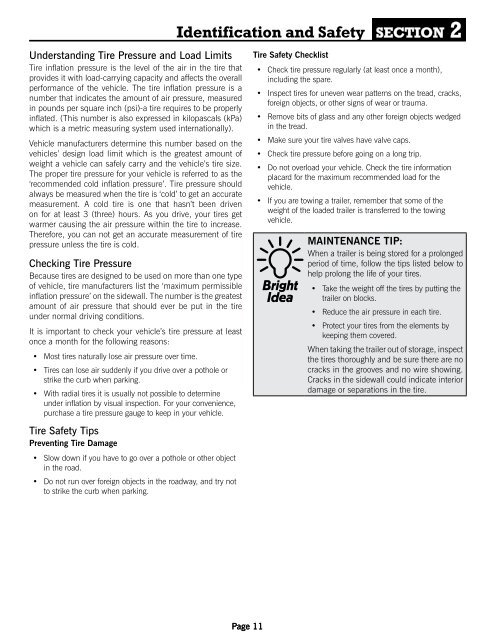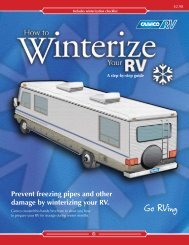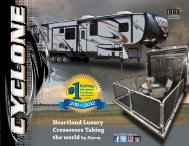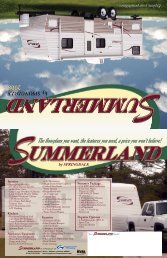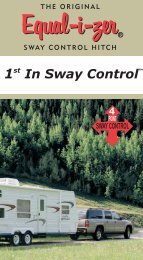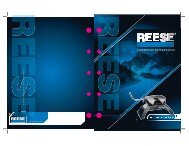Forest River Owners Manual - TTFW (PDF) - Pete's RV Center
Forest River Owners Manual - TTFW (PDF) - Pete's RV Center
Forest River Owners Manual - TTFW (PDF) - Pete's RV Center
Create successful ePaper yourself
Turn your PDF publications into a flip-book with our unique Google optimized e-Paper software.
Identification and Safety<br />
SECTION 2<br />
Understanding Tire Pressure and Load Limits<br />
Tire inflation pressure is the level of the air in the tire that<br />
provides it with load-carrying capacity and affects the overall<br />
performance of the vehicle. The tire inflation pressure is a<br />
number that indicates the amount of air pressure, measured<br />
in pounds per square inch (psi)-a tire requires to be properly<br />
inflated. (This number is also expressed in kilopascals (kPa)<br />
which is a metric measuring system used internationally).<br />
Vehicle manufacturers determine this number based on the<br />
vehicles’ design load limit which is the greatest amount of<br />
weight a vehicle can safely carry and the vehicle’s tire size.<br />
The proper tire pressure for your vehicle is referred to as the<br />
‘recommended cold inflation pressure’. Tire pressure should<br />
always be measured when the tire is ‘cold’ to get an accurate<br />
measurement. A cold tire is one that hasn’t been driven<br />
on for at least 3 (three) hours. As you drive, your tires get<br />
warmer causing the air pressure within the tire to increase.<br />
Therefore, you can not get an accurate measurement of tire<br />
pressure unless the tire is cold.<br />
Checking Tire Pressure<br />
Because tires are designed to be used on more than one type<br />
of vehicle, tire manufacturers list the ‘maximum permissible<br />
inflation pressure’ on the sidewall. The number is the greatest<br />
amount of air pressure that should ever be put in the tire<br />
under normal driving conditions.<br />
It is important to check your vehicle’s tire pressure at least<br />
once a month for the following reasons:<br />
Most tires naturally lose air pressure over time.<br />
Tires can lose air suddenly if you drive over a pothole or<br />
strike the curb when parking.<br />
With radial tires it is usually not possible to determine<br />
under inflation by visual inspection. For your convenience,<br />
purchase a tire pressure gauge to keep in your vehicle.<br />
Tire Safety Tips<br />
Preventing Tire Damage<br />
Slow down if you have to go over a pothole or other object<br />
in the road.<br />
Do not run over foreign objects in the roadway, and try not<br />
to strike the curb when parking.<br />
Tire Safety Checklist<br />
Check tire pressure regularly (at least once a month),<br />
including the spare.<br />
Inspect tires for uneven wear patterns on the tread, cracks,<br />
foreign objects, or other signs of wear or trauma.<br />
Remove bits of glass and any other foreign objects wedged<br />
in the tread.<br />
Make sure your tire valves have valve caps.<br />
Check tire pressure before going on a long trip.<br />
Do not overload your vehicle. Check the tire information<br />
placard for the maximum recommended load for the<br />
vehicle.<br />
If you are towing a trailer, remember that some of the<br />
weight of the loaded trailer is transferred to the towing<br />
vehicle.<br />
Bright<br />
Idea<br />
MAINTENANCE TIP:<br />
When a trailer is being stored for a prolonged<br />
period of time, follow the tips listed below to<br />
help prolong the life of your tires.<br />
Take the weight off the tires by putting the<br />
trailer on blocks.<br />
Reduce the air pressure in each tire.<br />
Protect your tires from the elements by<br />
keeping them covered.<br />
When taking the trailer out of storage, inspect<br />
the tires thoroughly and be sure there are no<br />
cracks in the grooves and no wire showing.<br />
Cracks in the sidewall could indicate interior<br />
damage or separations in the tire.<br />
Page 11


